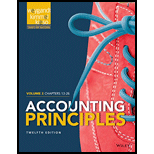
Concept explainers
(a)
Special Journal: The special journal is the journal which is prepared according to the needs of the business. This is a journal which is used to record the transactions which occur the most in the business. Generally, these are cash receipts journal, cash payments journal, sales journal, and purchases journal.
General Journal: A general journal records those entries which are not recorded in the special journal. The entries which are frequent in the business are recorded in the special journal. Rest of all the entries are recorded in the general journal like the closing
To determine: Journal in which the transaction (a) is recorded.
(b)
Journal in which the transaction (b) is recorded.
(c)
Journal in which the transaction (c) is recorded.
(d)
Journal in which the transaction (d) is recorded.
(e)
Journal in which the transaction (e) is recorded.
(f)
Journal in which the transaction (f) is recorded.
Want to see the full answer?
Check out a sample textbook solution
Chapter 7 Solutions
Accounting Principles, Volume 2: Chapters 13 - 26
- Chapter 6: Job costing Steel Manufacturing uses a job order costing system. During one month, Steel purchased $188,000 of raw materials on credit; issued materials to the production of $215,000 of which $10,000 were indirect. Steel incurred a factory payroll of $159,000, of which $20,000 was indirect labor. Steel uses a predetermined overhead rate of 150% of direct labor cost. The total manufacturing costs added during the period are___.arrow_forwardWhat is the accounts receivable turnover of this financial accounting question?arrow_forwardNo WRONG ANSWERarrow_forward
- Solve this Accounting problemarrow_forwardNo WRONG ANSWERarrow_forwardAt the end of the fiscal year 2023, Elliott Manufacturing Co. had net property, plant, and equipment (PPE) of $4.2 billion. The ending balance for 2022 was $4.150 billion, and the firm had depreciation expense during 2023 of $0.850 billion. How much did the company spend on new property, plant, and equipment (PPE) during 2023?arrow_forward
- If total assets equal $410,000 and total owners' equity equals $138,000, then total liabilities must equal_. (A) $548,000 (B) $272,000 (C) Cannot be determined from the information given (D) $138,000arrow_forwardAnswer with clear data. if you answer with any unclear dara then unhelpfularrow_forwardWhat was the amount of sales for the month ?arrow_forward

 AccountingAccountingISBN:9781337272094Author:WARREN, Carl S., Reeve, James M., Duchac, Jonathan E.Publisher:Cengage Learning,
AccountingAccountingISBN:9781337272094Author:WARREN, Carl S., Reeve, James M., Duchac, Jonathan E.Publisher:Cengage Learning, Accounting Information SystemsAccountingISBN:9781337619202Author:Hall, James A.Publisher:Cengage Learning,
Accounting Information SystemsAccountingISBN:9781337619202Author:Hall, James A.Publisher:Cengage Learning, Horngren's Cost Accounting: A Managerial Emphasis...AccountingISBN:9780134475585Author:Srikant M. Datar, Madhav V. RajanPublisher:PEARSON
Horngren's Cost Accounting: A Managerial Emphasis...AccountingISBN:9780134475585Author:Srikant M. Datar, Madhav V. RajanPublisher:PEARSON Intermediate AccountingAccountingISBN:9781259722660Author:J. David Spiceland, Mark W. Nelson, Wayne M ThomasPublisher:McGraw-Hill Education
Intermediate AccountingAccountingISBN:9781259722660Author:J. David Spiceland, Mark W. Nelson, Wayne M ThomasPublisher:McGraw-Hill Education Financial and Managerial AccountingAccountingISBN:9781259726705Author:John J Wild, Ken W. Shaw, Barbara Chiappetta Fundamental Accounting PrinciplesPublisher:McGraw-Hill Education
Financial and Managerial AccountingAccountingISBN:9781259726705Author:John J Wild, Ken W. Shaw, Barbara Chiappetta Fundamental Accounting PrinciplesPublisher:McGraw-Hill Education





